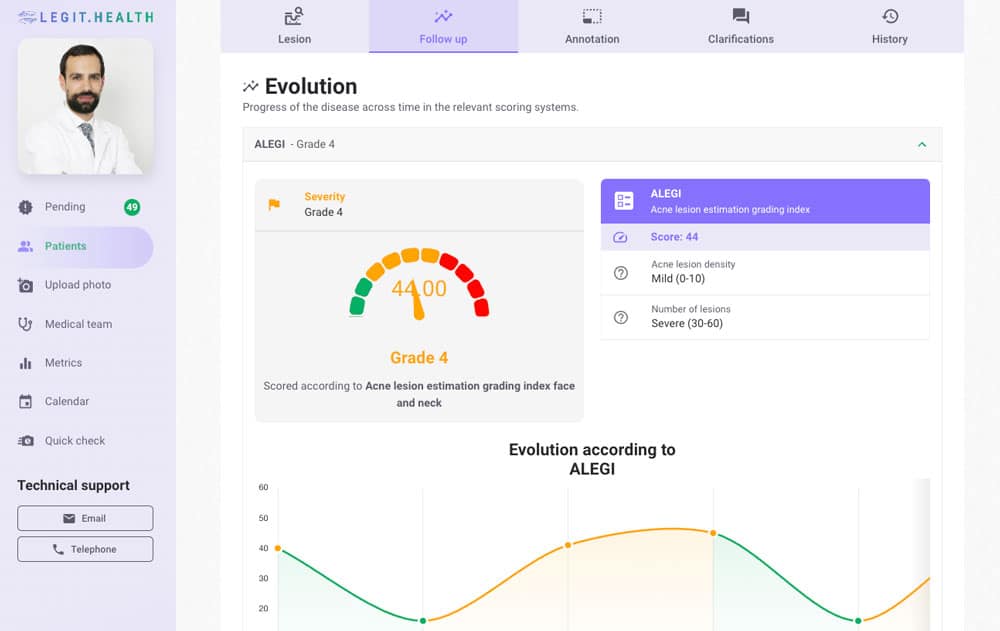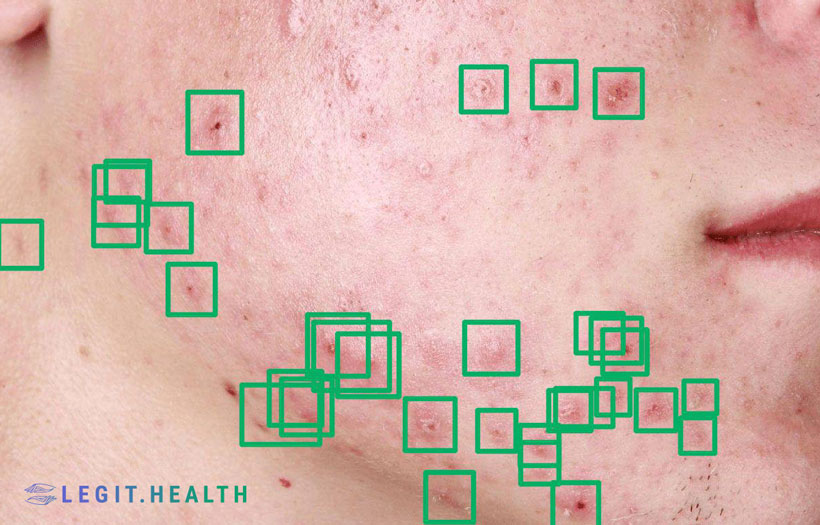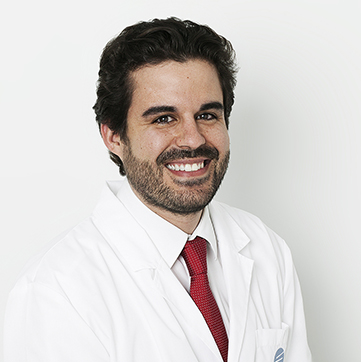Introduction
Dermatology has taken a giant leap forward with the introduction of Legit.Health's innovative ALEGI (Acne LEsion Grading Index). Leading researchers specializing in deep learning and neural networks have collaborated with renowned dermatologists to create this advanced algorithmic tool, designed to empower the next generation of medical professionals. This innovative solution integrates cutting-edge technology with expert medical insights, offering a robust platform for dermatological diagnosis and treatment planning.
It's widely known that objective, reliable, and precise outcome measures are key to the practice of evidence-based medicine. In the case of acne, is especially hard and tedious to apply the most accepted scoring systems, as they require the doctor to count lesions manually.
That's why Legit.Health has developed this tool that counts the number and density of acne lesions. Thanks to this, measuring the severity of acne is a task that only takes seconds.
The following screen capture of the Legit.Health tool shows a real-life use of the scoring system for acne. This can be used both on mobile and desktop.
The limited approach of traditional acne scoring systems
Since DM. Pillsbury and their team developed the first scoring system for acne in 1956, there has been a myriad of attempts to find an easy-to-use, reliable, and precise scoring system for this disease. Nowadays, more than 30 methods exist, and all of them share one of two underlying problems.
On one hand, some methods, such as GAGS, focus on lesion identification. These scoring systems try to achieve a high degree of accuracy by sacrificing speed and convenience for the physician. In the end, doctors tend to consider these methods too tedious and time-consuming.
One of the commonly used methods is lesion counting, which is time-consuming but might represent a more accurate method.
On the other hand, other methods like the IGA aim for a scoring system more usable in day-to-day practice. Sadly they achieve this result by sacrificing precision and reliability, making their use unfit for clinical trials.
Direct visual assessment and ordinary flash photography represent a normal clinical evaluation. However, both methods are compromised by viewer subjectivity.
And yet, we all agree that is essential to have an acceptable and easy-to-use tool for acne assessment that can be used both in day-to-day clinical practice and in clinical studies.
ALEGI: The best of both worlds
The fact that dermatologists have to choose between speed and precision in the 21st century is discouraging. Choosing is a sign of limitation, and technology should aim at freeing us of those limitations. That's where ALEGI comes in.
The revolutionary deep learning algorithm developed by Legit.Health takes the lesion-counting approach of traditional methods and elevates it to a new level, not only making it more objective, precise, and reliable but also substantially faster. The next-generation dermatologists finally have a tool that allows them to practice evidence-based medicine.
Using computer vision algorithms, ALEGI can precisely count the number of lesions shown in a picture taken with a smartphone. Additionally, it takes into account lesion density when calculating the severity, and translates it all to an easily interpretable outcome measure validated by experts in the field.
Do you want to see the clinical AI technology in action?
The ingredients of a brand-new scoring system
When developing a scoring system, it is vital to keep in mind some design principles to ensure that said scoring system fits its intended use. After all, a tool is only as good as its usefulness when completing the task it was designed for.
How do we know if a scoring system is good?
When it comes to dermatological assessments, the effectiveness of a scoring system is paramount. But what exactly makes a scoring system reliable and useful? Through scientific consensus, several key factors have been identified that contribute to the robustness of these systems. Let's delve into these crucial elements:
- Ease of Use: This factor considers whether the system can be applied effortlessly within the constraints of time and financial resources. A user-friendly system is crucial for widespread adoption in clinical settings.
- Sensitivity to Change: An effective scoring system must be capable of detecting clinically meaningful changes over time. This sensitivity ensures that any progress or deterioration in a patient's condition is accurately captured.
- Interobserver Reliability: This refers to the consistency of the results when different observers use the scoring system. High interobserver reliability means different clinicians will arrive at similar conclusions, enhancing the system's credibility.
- Intra-observer Variability: This looks at the consistency of results when the same observer uses the scoring system multiple times. Low intra-observer variability indicates that the system provides stable results, irrespective of repeated assessments by the same clinician.
- Interpretability: A practical scoring system should provide meaningful qualitative interpretations of its scores, like categorizing the severity of a condition as mild, moderate, or severe.
These criteria not only ensure the scoring system's effectiveness but also its applicability and reliability in diverse clinical scenarios.
Adapted from "Methods and definitions to rate the quality of outcome measures". Schmitt, J., Langan, S., Deckert, S., Svensson, A., von Kobyletzki, L., Thomas, K., & Spuls, P. (2013). Assessment of clinical signs of atopic dermatitis: A systematic review and recommendation. Journal of Allergy and Clinical Immunology, 132(6), 1337--1347. doi:10.1016/j.jaci.2013.07.008.
When the team of experts at Legit.Health developed the revolutionary ALEGI they considered the many criteria that are requisite to make a scoring system great at providing high-quality outcome measures.
The 7 most prominent qualities of ALEGI
The revolutionary tool developed by Legit.Health allows next-generation dermatologists to practice evidence-based medicine while speeding up the reporting process for the pathology and increasing the patient's autonomy and control.
This clinical data and communication app uses deep learning algorithms to relieve doctors from the tedious manual calculation of scoring systems, by automatically grading lesions by analyzing smartphone images and small patient-reported outcome measures (PROMs). In other words: the tool will automatically fill in most of the dermatology scoring systems for the most common diseases such as Psoriasis, Atopic dermatitis, Hidradenitis suppurativa, and, of course, acne.
This means that the new version of this scoring system extracts data precisely and consistently, both during routine evaluations and clinical research. The improvement can be seen in the following table, which compares the performance metrics of the most common way of using scoring systems:
| Pen and Paper | Digital | Automatic (AI) | |
|---|---|---|---|
| Self-supervision | - | - | Perform diagnosis |
| Ease of use | ≈ 600 seconds | ≈ 420 seconds | ≈ 23 seconds |
| Sensitivity to change | 0 to 4 | 0 to 4 | 0 to 100 |
| Interobserver variability | Medium (20%) | Medium (20%) | Lowest (8%) |
| Intra-observer variability | High | High | Zero |
Table 1: comparison between different methods of scoring the severity of a disease. The automatic artificial intelligence-powered method performs better across most performance indicators.
Thanks to the deep learning algorithms, Legit.Health relieves doctors from the tedious manual calculation of scoring systems and allows the practice of a more objective evidence-based dermatology. Also, by using algorithms to measure dryness, lichenification, erythema, oozing, oedema, and many more signs, the tool can calculate visual signs in a more reliably and consistently.
1. Faster than any other existing method
Most traditional methods of lesion counting require several minutes for an experienced doctor. Not only that, but it's a tedious process that most doctors try to avoid, preferring to take a few seconds to make a rough estimate of the severity of the illness.
ALEGI completely breaks this paradigm by automating the lesion counting process. In less than 23 seconds, a doctor can take a photo of the affected area, process it through the algorithm, and receive a measurement of severity without any of the subjectivity inherent in using clinical judgement.
The tool was developed by Legit.Health with the aim of ending this type of practice, which is deeply incompatible with evidence-based medicine, and to help doctors use real-world evidence to make therapeutic decisions.
2. Easy to use
One of the main problems facing healthcare systems worldwide is the bottleneck created by the lack of a reliable tool that helps primary care doctors determine whether a patient should be referred to a specialist.
This is due, among other things, to the difficulty of measuring the severity of acne. This complicates the prescription of treatment and limits the ability to track and monitor its effectiveness. To solve this problem, ALEGI has been designed to be easy to use by any healthcare professional.
Legit.Health contributes to solving this problem, as its tool is useful both for an initial diagnosis and for subsequent treatment monitoring. In other words, ALEGI assists both the specialist and the general practitioner in making informed decisions.

Do you want to see the clinical AI technology in action?
3. High degree of granularity
Legit.Health's tool analyzes the pathologies using a validated scoring system that has both the lowest MID (Minimal important Difference) and is sensible to the lowest LDC (Lowest Detectable Change), which means the algorithm analyzes every image with more precision and attention to detail than any human observer would.
Furthermore, ALEGI adds a new and revolutionary idea to the severity assessment of acne: lesion density. In the past, scoring systems have been limited by the ability of the user to properly count and identify papules, comedones, and pustules. Legit.Health's algorithm takes into account the tendency of these lesions to pile up together as a key factor in determining the severity of the disease.
All of this allows ALEGI to detect very small changes in the development of the pathology with greater precision than any human observer, giving the doctor access to more precise, objective, and reliable information.
4. Smaller margin of error
Thanks to the computer vision algorithms upon which ALEGI is based, each lesion is detected and counted individually, with an average absolute error margin of +/- 3 lesions. This achievement, combined with the ability to account for the density of lesions in a given area, allows the system to achieve a relevant and clinically validated severity assessment without the need to consider the different types of lesions.
This is significant because the literature shows that most of the errors made by doctors in assessing the severity of acne are related to the misidentification of the nature of a lesion, as in many cases the distinction is not clear or well-defined within the parameters of a clinical study.
Therefore, having a system like ALEGI, whose reliability does not depend on the ability to distinguish a papule from a comedone, improves accuracy and reduces the margin of error.

5. Zero intra-observer variability
Due to its algorithmic nature, ALEGI completely eliminates intra-observer variability, as the neural network is perfectly stable in its parameters. In other words, the application has a perfect memory of each image and each diagnosis it has been trained on, and therefore its results are completely realiable over time.
Estimating is guessing, counting is measuring
Legit.Health allows the doctor to not rely on his memory when assessing the severity of the affection and focusing on the analysis of the objective data stored in the app reduces considerably the risk of misremembering, providing a more objective, accurate, and precise way of tracing the development of the disease.
Although this becomes especially important in clinical trials, where reducing this kind of variability is key to gathering the precise data required in this kind of study, is also incredibly useful in the day-to-day practice of evidence-based medicine.
6. Provides accessible and easy-to-read data
The interface of Legit.Health has been designed to provide access to all patient information in a user-friendly and accessible manner.
All data generated by ALEGI is clearly displayed on the screen, showing the severity of the condition and each factor considered by the algorithm when analyzing the image and its score.
We can say goodbye to paper records and their tendency to get lost, as all patient information, from test results to relevant images, is stored in a constantly backed-up digital database that is securely accessible from a computer or phone.
7. The best way of following the progress of a treatment
Being acne a chronic disease, the follow-up after a successful diagnosis is crucial for the good development of the treatment.
Legit.Health allows the patient to become a more active part of their treatment by improving the communication between them and their doctor. The app achieves this by giving the user an easy and reliable way of sending accurate data to the doctor.
Additionally, the app displays the data in an easy-to-read graph showing the progress of the affection, allowing the doctor to answer the usually difficult question "Am I getting better, Doctor?" with scientific data to back their answer.
In conclusion
The revolutionary ALEGI represents the future of dermatology. Allowing doctors across the globe to practice evidence-based medicine by using the best tools during the disease diagnosis while improving the effective communication between doctor and patient.
The use of algorithms that estimate the severity of acne by counting lesions just by looking at smartphone images increases the doctors' correct diagnosis rate by 23% and improves the following of the treatment by making the patient a more active participant in their own recovery.
Work with us
At Legit.Health, we are working to further improve the technology of ALEGI, striving to create even better tools. This includes, for example, improving the differentiation between types of acne lesions, or ensuring that the technology works correctly across all skin phototypes.
If you would like to work with us, please fill out the following form and we will contact you as soon as possible.




